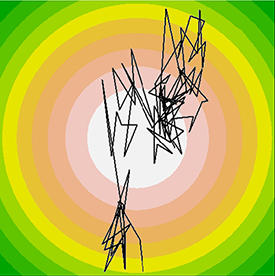

08/26/2013

Modified from Ref. 1 © 2013 American Physical Society
Developing high-capacity lithium ion batteries is an important research problem in materials science, and the realization of high-quality thin films of lithium metal oxides is a step toward this goal. Pulsed laser deposition (PLD) is a promising method of creating such films. In this technique, atoms from a lithium-containing source are vaporized using high-powered bursts of light, and the resulting ‘plume’ of plasma-phase atoms subsequently lands on a designated surface as a nanometer-thin coating.
However, when depositing films of electroactive materials such as lithium, the composition of the final thin film often differs from that anticipated. This ‘non-stoichiometric’ behavior makes it hard to predict the final result of particular fabrication strategies. Although the causes of the non-stoichiometry may be attributed to the volatile and chemically reactive nature of lithium atoms, quantitative explanations of this phenomenon have been lacking. Daniel Packwood, Susumu Shiraki and Taro Hitosugi from the AIMR at Tohoku University1 have made a discovery that should significantly improve the quality of PLD lithium-based thin films thanks to a model that describes collisions between high-energy atoms during the deposition process.
During experimental trials, the researchers noticed that adding background pressures of oxygen gas to the PLD chamber could change the proportion of lithium in the thin film structures. Intrigued by this result, they investigated this behavior — and the role of oxygen — with a theoretical model of the scattering process as a series of two-dimensional, head-on collisions between classical particles (see image).
After synthesizing several prototypical lithium–manganese oxide thin films at different oxygen pressures, Packwood, Shiraki and Hitosugi compared the films’ chemical composition to the predictions of their new model. The results were striking: the theory correctly mirrored the experimental results and revealed that the presence of oxygen gas caused lithium ions to scatter in erratic trajectories, often violently. Heavier manganese atoms pushed through oxygen practically unimpeded. According to the team, these findings indicate that lighter atoms will always show deficiencies when background gas pressures rise above a certain threshold — thus, source materials must be chosen carefully to achieve desired lithium compositions.
Packwood notes that the model works well because it captures the physics behind the critical energy exchange occurring during atomic scattering. This ensures reasonable thermal equilibrium in the model and predictions of spatial distribution that have proven experimentally valid. The team expects that their analysis can guide the fabrication of higher-quality interfaces that would lead to lithium ion batteries with higher charge–discharge rates by reducing the effects of electrical resistance.
Packwood, D. M., Shiraki, S. & Hitosugi, T. Effects of atomic collisions on the stoichiometry of thin films prepared by pulsed laser deposition. Physical Review Letters 111, 036101 (2013). | article
This research highlight has been approved by the authors of the original article and all information and data contained within has been provided by said authors.